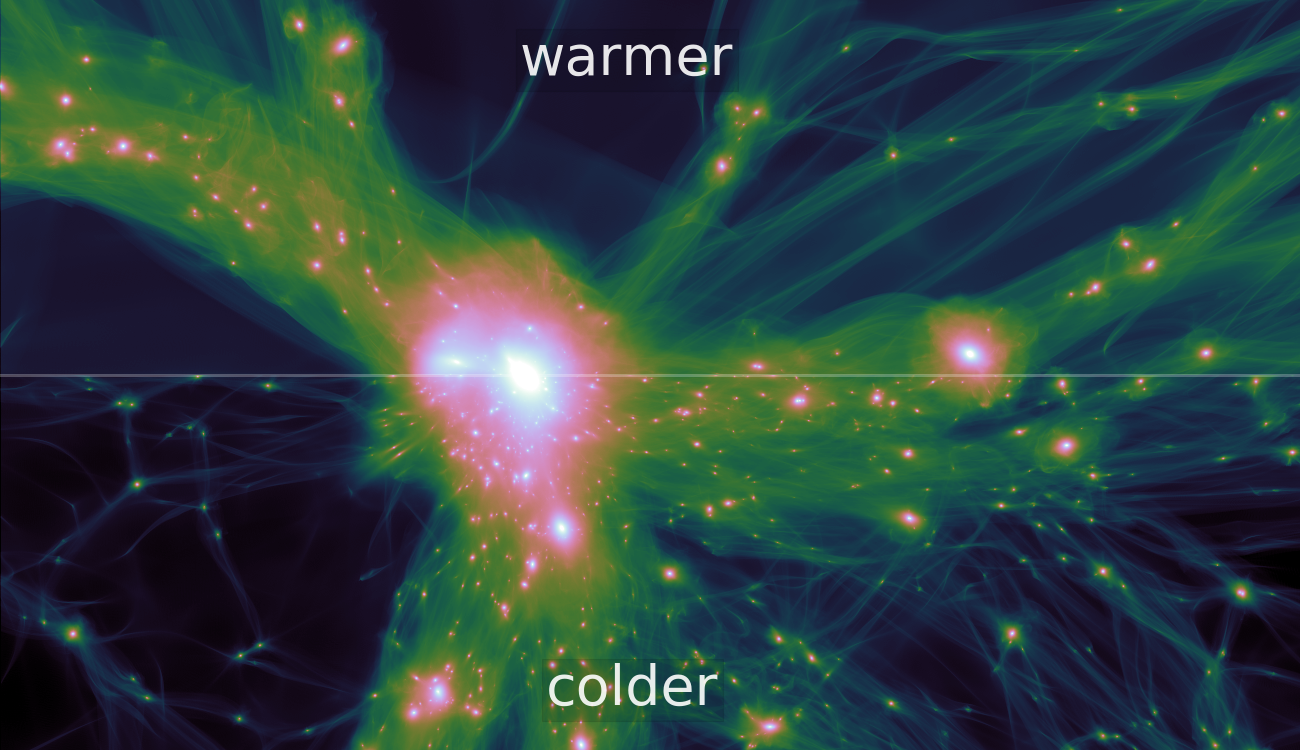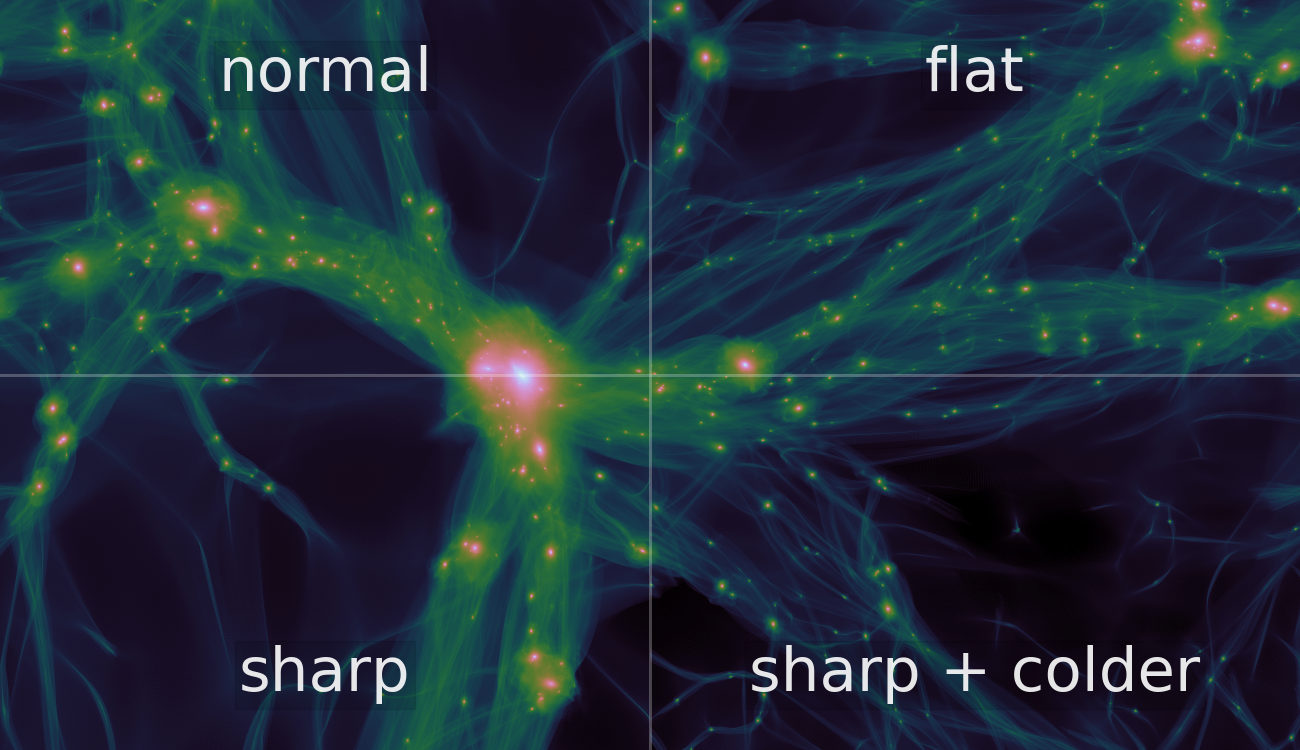The Nature of Dark Matter
There seems to be overwhleming evidence that most of the Universe is made of invisible dark matter, but unfortunately we do not know much about the concrete nature of it. It seems likely that dark matter should have certain properties like a warmth (referring to the thermal velocity dispersion), a self-interaction strength and a quantum wavelength. All these properties could leave some observable traces in our universe. For example, if dark matter is warm, the density perturbations on small scales would be surpressed through the free-streaming of dark matter. In this case fewer small haloes and galaxies could have formed in our Universe than if dark matter was colder. In principle, we could detect such differences observationally. This requires precise and reliable theoretical predictions.
Sheet + Release Simulations
We can predict the formation of structures by running large
cosmological simulations, for example the
Milennium Simulation
or the BACCO simulations.
Such simulations have typically been run with the N-body simulation
method. However, in universes with a surpression of small scale
structure (like warm dark matter) the N-body simulation method
produces large numbers of small
numerical artefacts.
As an alternative, "sheet" simulations have been introduced by
Hahn et al. (2013),
Hahn & Angulo (2016)
and Sousbie & Colombi (2016).
In these simulations the dark matter distribution is reconstructed to almost
perfect accuracy by interpolation of the
dark matter sheet in phase space, thereby showing incredibly
sharp density estimates and avoiding the artificial fragments of
N-body simulations. However, this comes at a price: the dark matter
sheet becomes incredibly
complex
inside of the dark matter haloes in the course of a simulation.
Therefore, the reconstruction becomes practically impossible in haloes,
leading to simulations that either have to be canceled early or
that give biased density estimates inside haloes. We could summarize the
situation in the following table:
| Simulation Method | Outside Haloes | Inside Haloes |
|---|---|---|
| N-body | Artificial Fragmentation | OK |
| Sheet | Perfect | Too Complex |
It seems clear that one could get a fully functional simulation
scheme by combining the best from both worlds. Therefore, we have
introduced in
Stücker et al (2020)
the "Sheet + Release" simulation method.
In these simulations, initially all mass is traced through the
dark matter sheet reconstruction. However, in regions where the
sheet becomes too complex (mostly haloes) the method automatically
"releases" mass elements into a set of mass carrying particles that
behave like traditional N-body particles. Therefore,
"sheet + release" simulations can reliably follow the evolution
of the density field inside and outside of haloes.
Here an example of how it looks in practice for a hot dark matter simulation:
Having an accurate density field outside of haloes is not only important for a reliable evolution of the simulation overall, but it might also be relevant for accurate predictions of gravitational lensing as investigated by Richardson et al. (2021).
The halo mass function of non-cold dark matter Universes
In Stücker et al (2021) we present the first set of reliable simulations of "non-cold" dark matter models -- run with the sheet + release scheme on the MareNostrum super computer. With "non-cold" dark matter we refer to any dark matter model that has a small scale surpression in the power spectrum. This includes the canonical "thermal relic" warm dark matter, but also other dark matter candidates like sterile neutrinos, ETHOS models, fuzzy dark matter and many more... Here you can see two of these simulations tiled together, one "warmer" simulation with a larger surpression scale ("1keV sharp" in the paper) and one "colder" simulation with a smaller surpression scale ("1.75keV sharp" in the paper):
You can see, how the colder case exhibits many more small scale
objects than the warmer one. This can be quantified through
the halo mass function. We have measured the halo mass function
in dependence of two parameters which describe the supression of
the initial power spectrum (one describing the slope and one the
length scale of the cutoff) and we have come up with a parametric
description of the halo and subhalo mass function that can be
evaluated for almost any non-cold dark matter model! You can find
a short python code for evaluating them here on github:
https://github.com/jstuecker/ncdm-mass-functions
We hope that these simple, but robust predictions will facilitate
constraining dark matter for future observational studies. Futher,
we hope to motivate other researchers to use to use observations
not only to constrain the fiducial thermal relic warm dark matter
scenarios, but also other non-cold dark matter candidates.
Jens Stücker -- in collaboration with Raul Angulo, Oliver Hahn and Simon White
Links & References
- Simulating the complexity of the dark matter sheet I: numerical algorithms
Stücker J., Hahn O., Angulo R. E., White S. D. M., 2020, MNRAS, 495,4943 - Simulating the complexity of the dark matter sheet II: the halo mass function of non-cold dark matter models
Stücker J., Angulo R. E., Hahn O., White S. D. M., 2021, arxiv (*)
- https://github.com/jstuecker/ncdm-mass-functions
- Non-Halo Structures and their Effects on Gravitational Lensing
Richardson T. R. G., Stücker J., Angulo R. E., Hahn O., 2021, arXiv:2101.07806




